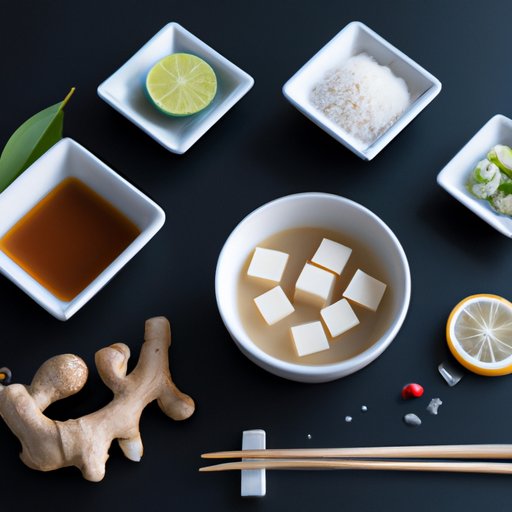I. Introduction
Miso soup is a staple in Japanese cuisine but has also become increasingly popular worldwide. Its signature umami flavor and health benefits make it a comforting and nourishing choice for any meal. In this article, we will explore the recipe for making miso soup, as well as the nutritional benefits, regional variations, ingredient education, and pairing suggestions. Whether you’re a seasoned miso soup maker or trying it for the first time, this article has something for you!
II. Recipe-based
Miso soup can be made with a variety of ingredients but typically consists of miso paste (fermented soybean paste) and dashi (a Japanese broth made from dried bonito fish flakes and/or kombu seaweed). From there, it’s customizable based on your preferences. Here is a basic recipe:
Ingredients:
- 1 tablespoon dashi powder
- 3 cups water
- 1/4 cup miso paste
- 1/2 cup firm tofu, cubed
- 2-3 tablespoons chopped green onions
Instructions:
- In a pot, bring water to a simmer. Add dashi powder and stir until dissolved.
- Lower heat to medium and add tofu. Cook until heated through, about 1-2 minutes.
- Place miso paste in a small bowl and add a ladleful of the broth. Stir until the miso is dissolved and add the mixture back to the pot. Stir to combine.
- Divide green onions into individual bowls. Pour soup over the onions and serve.
Adjusting the recipe based on your taste is easy – add more miso paste for a stronger flavor or substitute tofu with other proteins (such as shrimp, clams, or chicken). You can also add vegetables like seaweed, spinach, or mushrooms to the soup to vary the texture and nutritional benefits.
III. Health Benefits
The ingredients in miso soup provide a variety of health benefits. Dashi (the broth) is high in protein and minerals, while miso paste is a good source of probiotics. Together, they can aid in digestion and support the immune system.
Recent studies have also suggested that regularly consuming miso soup may help reduce the risk of cancer, heart disease, and stroke. In particular, the soy isoflavones in miso can help lower cholesterol levels and blood pressure. Moreover, the antioxidants in miso can help protect against free radicals and promote skin health.
IV. Regional Variations
While traditional miso soup generally consists of dashi and miso, regional variations have developed in Japan and beyond. For example, Kanto-style miso soup from Eastern Japan typically includes tofu and wakame seaweed, while Kansai-style from Western Japan may include darker miso paste and additional ingredients such as shiitake mushrooms.
Beyond Japan, miso soup-inspired dishes can be found in Korean and Chinese cuisine. The flexibility and adaptability of miso soup make it a versatile base for experimenting with different flavor palettes.
V. Ingredient Education
Miso paste is made from fermenting soy beans with salt and a fungus called koji. The fermentation time and the type of koji ultimately determine the flavor, color, and texture of the miso paste. The main types of miso are:
- White (shiro) miso – a mild and sweet taste, with a short fermentation time (around three months).
- Yellow (shinsu) miso – a slightly stronger taste, made with a mix of soy beans and grains.
- Red (aka) miso – the strongest flavor and darkest color, with a long fermentation time (up to three years).
White miso is typically used for soups and dressings, while the darker miso pastes are better for marinades and stews. Another option is to mix different types of miso paste together for a more complex flavor profile.
VI. Pairing and Presentation
Miso soup pairs well with a variety of dishes, from sushi to rice bowls to grilled meats. You can also experiment with different garnishes to add flavor and visual appeal, such as:
- Seaweed
- Sliced scallions or chives
- Mushrooms
- Cilantro
- Sesame seeds
When presenting miso soup, consider the vessel you use. A traditional Japanese lacquer bowl or a simple ceramic bowl can add to the experience of enjoying the soup. You can also top the soup with ingredients like chopped scallions or mushrooms for texture.
VII. Conclusion
Miso soup is a delicious and nourishing dish that has become popular worldwide. In this article, we’ve covered the basics of how to make miso soup, as well as its health benefits, regional variations, ingredient education, and pairing suggestions. By experimenting with different ingredients and flavors, you can create a miso soup that is uniquely yours!
So next time you’re in need of a comforting and healthy meal, give miso soup a try.
